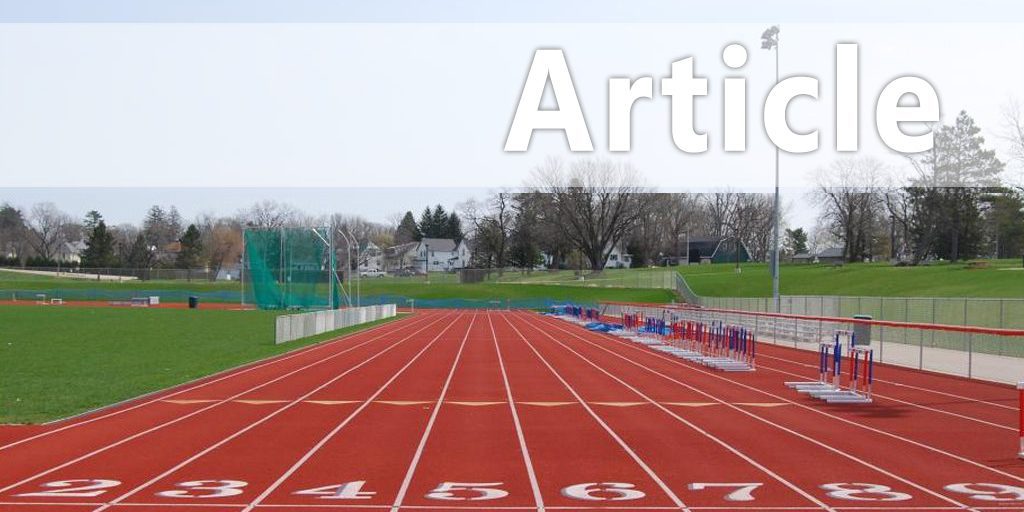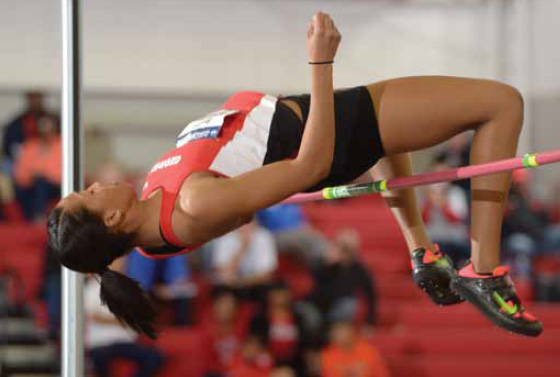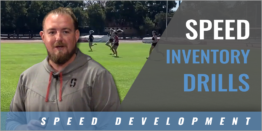| By Design - Physical Performance Components for the Jumps |
| By: Boo Schexnayder - Director of the Track & Field Academy
Originally Published in: Techniques Magazine Provided by: USTFCCCA STRENGTH RELATED COMPONENTS General Strength is the ability to overcome the internal resistance of and manage the displacement of one's own body and body parts. Since body control is implied, general strength is a functional component of all coordination related abilities, and an important part of relative strength capabilities. General strength training activities involve no external resistance, using bodyweight as the sole load. Power is the ability to produce force quickly. In situations requiring power, resistance must be overcome, and high speed of movement is also of great concern. Power seems to be a linking component between absolute strength and speed qualities, and most training systems treat it as such. In track and field, where time available for force application is so often extremely short, the need for high power production capabilities becomes obvious. Power training activities combine resistance and high speeds of movement. Reactive Strength is the ability to produce force using the stretch shortening cycle. This production of elastic energy is essential to efficient and high level performance in all speed and power oriented events, and training programs must prioritize development of this quality. Most reactive strength training involves plyometric or multi-jump exercises. All skeletal muscle and nearly all training components possess the potential for elastic energy production and reactive strength development. Strength Endurance is the ability to sustain force production. Strength endurance is a concern in stabilizing and postural muscle groups, which must be able to Strength Endurance is the ability to sustain force production. Strength endurance is a concern in stabilizing and postural muscle groups, which must be able to SPEED RELATED COMPONENTS Accelerative Power is the ability to effectively move the body from rest and quickly approach maximal velocities. Inertia must be overcome in these situations, thus resistance exists. Therefore, accelerative power is related to one's power capabilities. Acceleration should not be confused with absolute speed, and acceleration training activities involve moving the body from rest to high speeds. Absolute Speed is the maximal locomotive velocity attainable. In most situations we are concerned with the rate of movement of the body as a system, but the speed of individual body parts is an important component of absolute speed. This quality should not be confused with acceleration, and absolute speed training activities involve attaining and maintaining maximal velocities for short periods of time. Speed Endurance is the ability to maintain absolute speed and resist the inherent degradation of absolute speed that occurs in performance. Once the body reaches its maximal velocity, deceleration inevitably occurs within a few seconds. Speed endurance refers to the ability to resist this deceleration. This deceleration is associated with the buildup of certain byproducts or muscle contraction, but of more concern to us as a cause is a loss of coordinative ability. The inability to coordinate high speed movements for extended periods of time is essentially a form of nervous system fatigue, so speed endurance should be considered as a specific type of coordination training. Speed endurance training activities involve maintaining maximal velocities for extended periods of time. Optimal Speed is the speed which best optimizes the performance of some motor task. Increasing speed in performance gives the potential for greater success, but only if coordination and technical execution don't suffer. Optimal speed can be regarded as a combination of speed and coordination abilities. ENDURANCE RELATED COMPONENTS Aerobic Fitness can be considered as two subcomponents, aerobic capacity and aerobic power. Aerobic capacity is the ability to perform large amounts of aerobic work, while aerobic power is the ability to perform a single extended aerobic effort. Aerobic training activities involve intensities sufficiently low enough to keep the body in an aerobically fueled state. Aside from the need to consume oxygen during recovery from work, aerobic fitness is of little concern in the jumping events. Glycolytic Fitness can be considered as two subcomponents, glycolytic capacity and glycolytic power. Glycolytic capacity is defined as the ability to perform large amounts of anaerobic work, while glycolytic power is defined as the ability to perform a single extended anaerobic effort. The ability to perform while experiencing oxygen debt and the associated acidosis and lactic acid buildup is part of one's glycolytic power capabilities. Glycolytic training activities involve intensities sufficiently high enough to force the body into a glycolytically fueled state. Because of the low energy systems demands associated with jump performance, glycolytic fitness concerns center around prerequisites for performing certain types of specific training, and stimulation of the body's recovery processes. Endocrine Fitness is a state of the body in which the presence and levels of certain hormones support improvements in performance and recovery from training. Developing endocrine fitness involves prescribing training components that stimulate anabolic hormones and recovery processes. Work Capacity is the ability to withstand large training loads. While the aforementioned energy system fitness levels do play a part in determining one's work capacity, the levels of various components of coordination and strength play a greater role. A person who is technically efficient at a task, and whose strength levels enable operation at a lower percentage of maximal power output, will experience fatigue when performing that task much later than a person who does not possess these advantages. Achievement of high training volumes without sacrificing quality of work develops work capacity.
FLEXIBILITY RELATED COMPONENTS Active Flexibility is the range of motion attainable at a joint without any outside forces acting upon the joint. Active flexibility training activities require movement into positions that challenge active flexibility limits. Passive Flexibility is the range of motion attainable at a joint with assisting force. Passive flexibility always exceeds active flexibility. The athlete or the environment may provide the assisting force. Passive flexibility training activities require assisted movement into positions that challenge passive flexibility limits. Kinetic Flexibility is the range of motion attainable at a joint with the assistance of momentum. Usually the momentum of a body part supplies an assisting force. Kinetic flexibility training activities require ballistic movement into positions that challenge kinetic flexibility limits. COORDINATION RELATED COMPONENTS Agility is the ability to perform acyclic movements quickly and accurately. Quick starting, stopping, and changes of position and direction are agility demanding tasks. Since speed of movement is necessary in agility demanding situations, speed qualities are requisite to agility, as well as coordinative qualities. The body control needs in agility related tasks imply the importance of good general strength levels, and many general strength deficits masquerade as agility problems. Agility training activities require these types of movement. Mobility is the ability to move joints through large ranges of motion in accordance with the demands of some particular motor task. Unlike flexibility related qualities, a task is denoted and a coordination demand is present. This quality is specific to a task and functional. Mobility training activities normally assign some technical task that by nature demands great amplitudes of movement. Balance is the ability to maintain stability. Balance is a necessary component of coordination and all athletic tasks. Balance is trainable but is often neglected, since balance problems are not readily visible at the high velocities of competitive athletics. Balance training activities normally require mastering slow movements or stationary positions that create the opportunity for instability. Technical Execution is the ability to perform a motor skill accurately and repetitively. Technical execution refers to the actual specific skills we find in track and field events. It is important to note that the development of these skills is largely dependent upon other coordination capabilities, and improving these is often prerequisite to effective teaching of the desired skill. Technical execution training features movements that greatly replicate competition. The effective coach constantly evaluates training in light of these abilities and each ability must be addressed in some way in the program. While equal distributions of training time and training effort across the board are not desired, over-specificity presents a unique set of risks as well. The art of coaching involves understanding the proper sequencing of the training of these abilities and the amount of time and effort proportionally devoted to each at any point in the training calendar. This article was taken from the curriculum of the Jumps Specialist Certification of the Track & Field Academy. Boo Schexnayder is the Director of the Track & Field Academy and the author of this course curriculum. |







